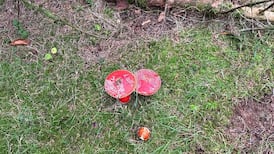“What are you doing up there, an educated man like you?”
The neighbour standing below me on the bog road would never quite understand what I was up to. And as I stood to catch the last turf atop our tractor-load, the mountain rain trickling down my neck, it might have felt hard to answer.
How many, I wonder, of the 76,000 households that still burn turf now actually take a sléan to the bog to cut it for themselves? In the townland I came to at the end of the 1970s, the spring exodus to the bog, often of whole families, was part of the small-farm calendar of self-sufficiency.
Something of the sort was my own aspiration, as we settled to “alternative living” on a hillside acre, in a Land Commission half-house with an old Stanley range in the kitchen. The house hadn’t known a fire in years, but still had its own patch of turbary – the old tenants’ right to cut turf – somewhere on the flank of the mountain.
No one was sure where it was, but an indulgent consensus steered me to a steep, well-worn bank still edged with tough vegetation. The first, back-breaking task was to strip out a margin of this heathery scraw to reach the first dark peat.
The sléan, a narrow spade with a right-angled wing, pushes into the peat to carve out a wet, heavy brick of it, thrown in a single, smooth lift to land at random, to one’s right, on the dry bog. Then again and again another dozen times, one eye on the unmatchable rhythm of one’s neighbour and the way his sods landed in neat rows the way God intended.
Seamus Heaney, who cut turf as a boy, wrote of the bog: "The ground itself is kind, black butter, melting and opening underfoot." It can also hide surprises, as when the sléan bites into the tough red bone of a long-buried stump of Scots pine, a relic of the last big climate change.
Bony haunches
As to climate on the bog, this swings about with the clouds one sees coming, even from the ocean’s far horizon. In shirtsleeves on a fine day, with meadow pipits aloft and singing, the bog breathed such life into one’s being.
For the other dark, midge-bitten days, I think of one lone figure, wearing a sack on his head, cut down one side as a cowl, and working on to foot his turf in the rain. “The old people used to say,” he boomed across to me, “that if you haven’t got your turf out from Cinnacoille by June 24th, you won’t get it home at all.”
The same man would trot past my gate in winter, riding a donkey as if its bony haunches were a comfortable armchair. This let him embrace the big bale of hay he was taking to distant cattle. But he never had the help of his donkey on the bog – its hooves were quite the wrong shape.
In the cameos of tourist postcards, the animal is burdened with turf-piled cliabhs and led off the bog by children with auburn curls. Is the animal’s lowered gaze one of patient service or stoical suffering?
The Donkey Sanctuary and ISPCA still rescue abandoned donkeys with hooves overgrown into long Turkish slippers, a neglect they deplore as inherently cruel. But this was the common state of most donkeys kept for work with cliabhs, since the extra spread of hoof kept them from sinking into the bog.
A donkey used for road work, however, had its hooves worn naturally to a sharp edge, as on the dry, stony surfaces of its Middle Eastern origins. Generously loaned such a beast for my own bog burdens, I coaxed him to the footings of turf and set about filling the cliabhs. He began to sink one corner at a time, like a heavy chair on rotten floorboards.
Two-tone bray
It’s years since I smelled turf smoke adrift on the evening hillside (we now burn wood) or heard the half-strangled, two-tone bray designed originally for contact in the deserts of Nubia.
Most of Ireland’s modern turf harvest is now cut by local contractors with machines, though footing, stacking and getting the dry sods home can still take laborious days on the bog. In 2008, economist David McWilliams noted a tripling of prices for roadworthy donkeys as turf-cutting farmers in Connemara sought relief from the high price of tractor fuel.
Could this happen again, in odd new alignments of energy? First, find your donkey: one early export market led them northward to pet-food factories in Scotland. Today, most survive in the donkey sanctuaries of both islands, or as pets for families that can afford, as the ideal, a six-weekly hoof-trim by a farrier.










